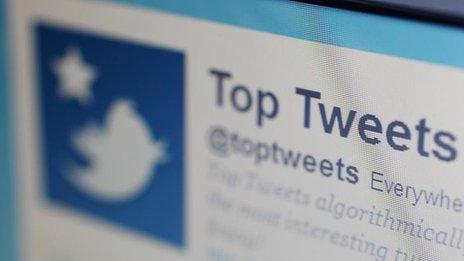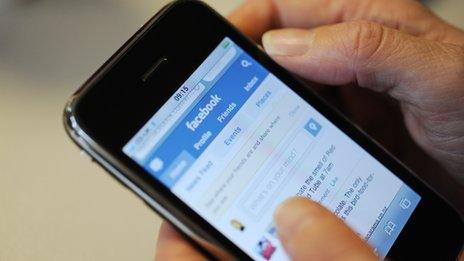Are Twitter and Facebook changing the way we complain?
- Published

Twitter is increasingly being used by consumers to give them a voice with which to communicate with companies
Is social media the new battleground on which individuals air their grievances about big companies?
A sense of lonely rage, after being mistreated by a big company, is a feeling many can relate to.
Rudeness, poor service or inexplicable disruptions announced by unswervingly unapologetic staff - sometimes minor injustices are the ones that rankle the most.
And, when faced with a seemingly impassive company, the outlets by which customers could seek justice - or at least complain - have traditionally involved sending a letter or contacting a call centre.
But a new trend appears to be emerging in which people are taking to social media platforms to air their grievances.
A survey conducted by communications agency Fishburn Hedges and Echo Research points to this phenomenon.
It polled 2,000 UK adults and found that, in April 2012, 36% had used a social media platform to contact a big company.
Some 65% of those surveyed said they believed social media was a better way to communicate with companies than call centres.
And while half of people aged between 18 and 24 engaged with big brands in this way, the tactic was not restricted to young people.
Researchers found just over a quarter - 27% - of those surveyed aged 55 and above had contacted companies using social media.
Peter Davis complained on Twitter after he bought a computer online only for a microwave to be delivered to his Brighton home.
"This was preferable to calling their customer services line and being put on hold for inordinate length of time listening to pulsating dance music," he says.
"Once my tweet was published someone from the company contacted me almost immediately. The next day I received a parcel containing the item I initially ordered."
And he is not alone.
When Jennifer Hardi found herself on a crowded train platform, following disruption to the regular service, she sent a tweet to the rail operator's customer service team and received an apology within minutes, along with a revised timetable.
"It's a shame that if you have a complaint you have to resort to public humiliation and publishing a tweet to get your case heard and resolved quickly," says Bryan Allworthy, who used the same strategy to great effect when his telephone and internet service experienced intermittent disruption.
Mr Allworthy, who runs his own consulting business, goes on: "I got bogged down with call centre reps that refused to escalate the problem and get someone who knew how to fix the system.
"Within half an hour of tweeting the marketing department of both firms got on the case, working quickly to resolve the matter."
Not only Twitter fulfils this role. Although the ability to send a short message into a public sphere makes it particularly convenient, Facebook and Google+ are also places where firms are engaging with their customers.
The issue of "public humiliation" seems to be the key point, with big firms doing their best to protect their reputations.
The quick, efficient response that these efforts evoke forms what Eva Keogan, head of innovation at Fishburn Hedges, calls "VIP treatment from brands on social media".
"Fear of public complaints evens up the balance for us all. However, the smartest businesses are the ones that will manage to avoid injecting needless processes," she says.
"Social media can bring a business and its customers much closer."
<bold>'Bashtag' danger</bold>
But the use of social media - particularly Twitter - to engage with customers can also backfire.
Qantas discovered this last November when it encouraged people to use the Qantas Luxury hashtag to share positive experiences of flying with the Australian airline, incentivising participation with a prize of luxury pyjamas.
Instead, <link> <caption>it was inundated with thousands of complaints and sarcastic comments from disgruntled customers</caption> <url href="http://www.theage.com.au/national/a-qantas-luxury--not-having-to-face-flak-20111122-1nsy3.html" platform="highweb"/> </link> who felt the service they received could not have been further from what they considered to be luxury.
McDonald's was also stung by the unpredictability of social media when it created the McDStories hashtag in January, hoping it would unleash a stream of positive tweets extolling the virtues of its dining experience.
The fast-food behemoth <link> <caption>reportedly stopped using the hashtag after just two hours, saying the effort "did not go as planned"</caption> <url href="http://www.latimes.com/business/money/la-fi-mo-mcdonalds-twitter-fail-20120123,0,7220567.story" platform="highweb"/> </link> following a barrage of negative tweets.
But by then the hashtag had taken on a life of its own and continued to be used.
One person tweeted: "I only eat McDonald's when I am ill because it makes me feel sick anyway."
Another wrote: "Dude, I used to work at McDonald's. The #McDStories I could tell would raise your hair."
Such behaviour <link> <caption>led to the term "bashtag" being coined</caption> <url href="http://www.theatlantic.com/technology/archive/2012/01/neologism-watch-from-hashtag-to-bashtag/251924/" platform="highweb"/> </link> to describe situations in which a corporate Twitter hashtag is used to criticise the company.

The ubiquity of smartphones means it is increasingly easy for people to share their thoughts on social media
This exemplifies what Thomas Brown, of the Chartered Institute of Marketing, calls "the democratisation of conversations".
He says big companies had previously enjoyed a "controlled" conversation with customers in which they promoted their wares through advertisements.
Unhappy consumers could only respond with a small voice, through letters or calling a customer relations team, but companies cannot control social media conversations.
"Now there is a risk that you could have a groundswell of customers talking to each other and, from the brand's perspective, it can get out of hand very quickly," he said.
"As millions more catch on to this great route into traditional customer service channels, the challenge for brands will be maintaining the same level of service," says Ms Keogan, of Fishburn Hedges.
Call centre replacement?
She warns that while it is "fantastic to get a better service through social media" consumers "may find this is short-lived" as businesses develop strategies to deal with such complaints.
Some have questioned whether the rise of social media marks the beginning of the end for call centres.
In the Philippines, which with more than 600,000 call centre workers recently overtook India as the world leader in the field, efforts are already being made to incorporate social media responses in to the workload of staff.
<itemMeta>news/business-18061909</itemMeta> allowing employees to instantly see every message, no matter how it comes into the centre.
Experts agree that the future is uncertain for this nascent form of dialogue between companies and consumers.
Richard Dodd, of the British Retail Consortium, points out that dealing with social media complaints "has the potential to need more staff" and could therefore prove to be costly.
"If you are actively engaging in social media you are setting up an expectation amongst customers that they will receive a response, so you have to be geared up to fulfil those expectations," he says.
But one thing does look certain.
That sense of rage at perceived injustices no longer has to be a private conversation between the consumer and a small cog in a big machine.
- Published15 May 2012
- Published11 November 2011